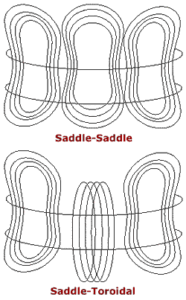The most common form of deflection yoke used in early colour monitors is known as a saddle-toroidal yoke. Its name comes from the shapes of the vertical and horizontal deflection electro-magnets’ windings. The winding of the electro-magnet used for vertical beam deflection is saddle shaped, while the one responsible for horizontal deflection takes the form of a torus, i.e. is doughnut-shaped. The word saddle is used because the shape of the coil is similar to that of a horse’s saddle.
One of the drawbacks of this type of yoke is that the shape of the magnetic field generated by a toroidal winding produces high levels of ELF radiation because it is wound around the magnetic core, while the saddle coil is contained within the magnetic core.
The arrival of emission level guidelines for monitors led to the toroidal yoke being replaced by a second saddle-shaped winding, which has lower emission characteristics and with which a cancelling coil could be used to reduce the remaining radiation to acceptable levels. A yoke with two saddle coils is known as a saddle-saddle deflection yoke (S-S D/Y).
The saddle coil-winding is more complex to design and manufacture than the toroidal, and the addition of a cancelling coil wound in the direction opposite to the main coil makes it more so. However, its lower emission levels make compliance with MPR and TCO emission levels possible and also cut down the level of interference between monitors, allowing them to be positioned closer together.

